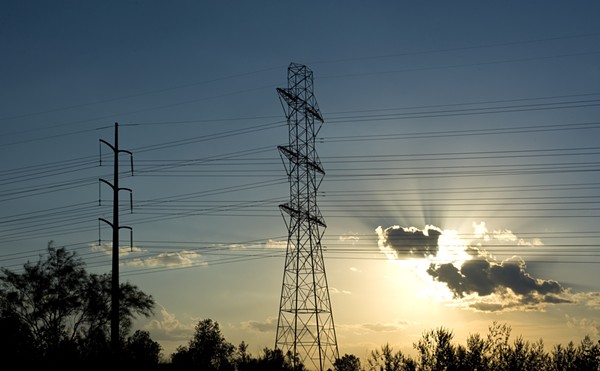The bad news is that a recent public health assessment doesn't alleviate fears that residents' health and the Edwards Aquifer might both have been affected. The Agency for Toxic Disease Registry (ATSDR) and the Texas Department of Health have issued a 25-page document on the R&H site; citizens can comment on it through January 17, 2003. (See box, this page.)
Last year, the Environmental Protection Agency recommended that R&H be placed on the National Priorities List, which would make it a Superfund site, a status reserved only for the most polluted areas in the U.S. In October 2001, the EPA removed hazardous materials in the tanks, processing equipment, piping, and some tainted soil. Additional contamination remains in the soil and groundwater.
The ATSDR, which conducted a similar health assessment for the nearby Kelly neighborhood, again has failed to adequately measure how much damage the R&H pollution may have inflicted on area residents' health and the Edwards Aquifer.
Armando Quintanilla, a former Kelly neighborhood resident and current member of the Kelly Air Force Restoration Advisory Board pointed out that, like the Kelly investigation, this report didn't study air inside neighboring homes for contamination. Nor did it examine groundwater wells outside the site. "It didn't mention elevated cancers that were found in the Kelly study," he added. "There was no mention of low birth rates."
The Kelly study found evidence of low birth rates and elevated rates of some cancers; the R&H neighborhood can also be considered part of the Kelly area because it is so close to both sites. Yet, no detrimental health effects were found in the R&H study.
The study says ATSDR officials contacted some residents by phone, but the assessment didn't say how many people the agency reached, nor if any interviews were conducted in Spanish (95 percent of the neighborhood is Hispanic).
As for pollution of the water source, the R&H study claims the Edwards is protected from contamination by a 530-foot-thick layer of clay, yet contradictorily, the EPA recommended R&H become a Superfund site because it recognized a potential release to the Edwards Aquifer.
Since the ATSDR relies on other agencies for data, its studies are often incomplete. In the R&H study, there was incomplete data for surface water and air contamination; as reported in the Current in July 2001, the Texas Cancer Registry is years behind in collecting tumor and cancer data, so accurately gauging the cancer rates also is impossible. In 1991, the ATSDR came under fire from the General Accounting Office, the investigative arm of Congress, which concluded the agency's studies were often incomplete and of limited usefulness.
"There are many questions," Quintanilla said of the R&H study.
For about 60 years, R&H Oil, also known as Tropicana Energy, refined crude oil and blended fuels near a residential neighborhood on Somerset Road. During that time, it spilled thousands of gallons of gasoline and black, oily liquids that reached the groundwater and a shallow aquifer, and added misery to a neighborhood already saddled by pollution from nearby Kelly Air Force Base.
In the 1990s, after state and federal environmental agencies cited the company for numerous violations, the polluters abandoned the site and their responsibility for their negligence.
The future of contamination at R&H is uncertain, as it has not been officially designated a Superfund site, and is not eligible for federal funding under that plan. Budget cuts at the Environmental Protection Agency have curtailed hundreds of federal cleanups, and according to the EPA's Cynthia Fanning, it could be May 2003 before the agency decides whether additional federal dollars will be available for R&H.
Until the polluters come forward to clean up the site and an adequate health study is done, the 17,000 residents and the children, teachers, and workers in the 10 schools near R&H are in the dark about what is lurking in their air, water, and soil.
PINPOINTING THE POLLUTERS
These companies have been identified by the Environmental Protection Agency as "potentially responsible parties" to the contaminated R&H Oil site. On September 13, the EPA sent them general notice letters telling them they could be among those responsible for pollution. According to the EPA's Region 6 Press Officer Cynthia Fanning, the agency has started corresponding with several companies, who "are talking amongst themselves."
A-1 Lee Oil Service
Defense Reutilization and Marketing
Service (DRMS)
EG&G Automotive Research c/o
Perkin Elmer Automotive Research
Firestone
Philip Holcomb
Howard Kolb
Mission Transport
National Lube N Zoom c/o
National Radiator
John R. Cook c/o S & J Petroleum Inc.
SMI (Structural Metals, Inc.)
Southwest Research Institute
Stewart Stevenson
Wing Corporation
Flint Ink
COMMENTS NEEDED ON HEALTH STUDY
The Agency for Toxic Substances and Disease Registry (ATSDR) and the Texas Department of Health have issued the 25-page health assessment for the R&H Oil Company, also known as Tropicana Energy. Copies are available at the Pan-American Library, 1122 W. Pyron Avenue. Citizens can comment on it through January 17, 2003.
Written comments should be sent to Tom Ellerbee, Texas Department of Health, Bureau of Epidemiology, 1100 W. 49th Street, Austin, Texas 78756.


















